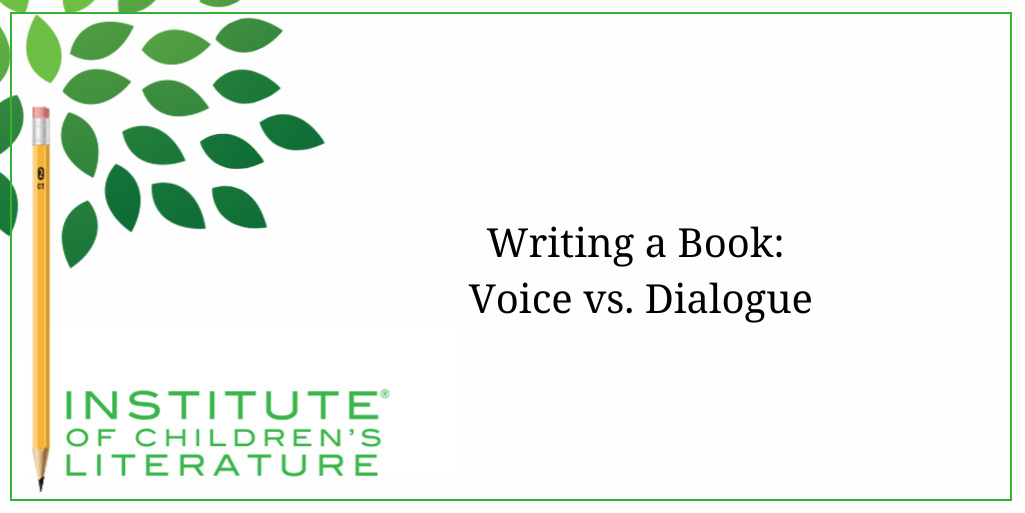
5 Ways Writers Can Prep for 2025 Goal Setting
Before we roll on to the new writing year, let’s harness our optimism for the blank slate before us and prepare for our 2025 Goal Setting just for writers.

When writing a children’s book, you need voice and one of the most vital elements of dialogue is voice. Voice consists of the words your characters say (in their heads and aloud) and the ways they say them. A character’s voice can be affected by their personality, their background, and the decisions that character makes about how they want to present themselves.
Each character needs a separate and distinct voice to help readers connect to the characters and to differentiate them when reading the dialogue. It is one of the best tools writers have to draw readers in and make them believe in your story and your characters.
Writers are pack rats, picking up bits and pieces of the real world to use in stories. We notice sensory details, visuals, and sounds all around us so we can use these things again to make our stories real. This same pack-rat behavior can help writers develop voices for our characters. The key is the occasional bit of eavesdropping.

Listen to a variety of people and make notes about the unique ways of speaking in terms of word choice, vocal tics, volume, and how people move as they speak. As you hear people speak, ask yourself, what sense do I get about how this person feels as they are speaking? What clues led me to that conclusion?
If you aren’t comfortable with eavesdropping in public, you can find lots and lots and lots of videos online where people have recorded themselves and others talking. Make time to run through such videos, noting differences in how people talk about the same things, and how the way they speak reveals things about them. Watch for age markers in how people speak. Are there specific words that young people use more often than older people? Are there differences in volume or movement when people speak? The more you notice, the more you can carry these things over to give your own characters clear, unique voices.
Don’t be afraid to use dialogue tags to help. Many times writers are given the direction to only use “said” as a dialogue tag, but this is the sort of advice to take with a grain of salt. Sometimes the way a character speaks is as important a part of voice as the words they say. That doesn’t mean you add an adverb to every speech tag or that you should never use said, but it can be helpful to know someone lisps because of their retainer or has a voice that breaks when they’re excited.
Keep in mind that dialogue is more than sounds and the way the sounds are made. Dialogue is also full of action. Do characters wave their hands or stuff them in their pockets when they speak? Do they fold their arms over their chests or put their hands on their hips and thrust out their chins? Little movements by a character can be part of giving the person a real personality and a real voice.
Even small things can affect voice in dialogue. If you’re like most writers, you already use one of them. Because children tend to be more emotionally out there than adults, many of us give in to the temptation to render everything children say as an exclamation. This is also a kind of voice:
“Hi! I’m new here!” Jake jumped up and down. “I like dinosaurs and marshmallows!”
The only problem with using punctuation to help with voice is how quickly the reader’s brain simply stops seeing it, thus rendering it useless in this role. So consider this kind of voice as a sprinkle, not a pour.:
Jake raced up to the girl. “Hi! I’m Jake.” When she didn’t answer quickly, he added, “I like dinosaurs and marshmallows.”
By adding in things like Jake’s eagerness to meet someone new (shown in his racing up and his inability to wait until she responds) you do more to show things about him and therefore strengthen the voice in which we read the dialogue, than you would manage with all those exclamation marks.
Exclamation marks are also not the only punctuation with voice potential. A character who pauses a lot when he speaks or a character who is timid and turns statements into questions would also be examples of voice through punctuation. So would someone who trails their sentences off as if they run out of energy before the end. These kinds of voice signals would use commas and question marks and ellipses, but remember to do this kind of voice signaling lightly. A sprinkle, not a pour.
Main characters give writers an extra opportunity for voice because they have both the voice they use in dialogue and the voice in their head, the voice of their thoughts. Now thoughts are rendered differently on a page from spoken words. Dialogue is set in italics, not quotation marks. For instance:
Jenny gave the newcomer a polite smile. “I’ll be sharing my bedroom with you now.” And you better keep your mess on your side.
In this bit, Jenny is outwardly polite, but inwardly raging over having to share her bedroom, so the voice is different when it’s in her head. In her head, she says the things she doesn’t dare say aloud. Inner voice gives the reader a more well-rounded picture of a character, but it should be used sparingly as it can lose its unique forcefulness quickly.
Inner thoughts are only rendered in italics when they are her exact thoughts in the moment. This kind of inner dialogue is immediate and close. But you can also give the main character thoughts with more distance, as a kind of report of what she thought. In that case, it wouldn’t be in quotes or italics. Here’s an example:
Jenny fumed about having her cousin in her room. She fumed about Alice’s ridiculous number of stuffed animals, and thought she’d throw up when Alice asked to hang up a poster of a big-eyed puppy. How nice am I supposed to be? But she’d smiled, and nodded, and said, “Of course. It’s your room too.” For now.

photo credit: timur weber via pexels
See how this bit goes in and out of closeness. Only when the thoughts are immediate do you use italics. In that case, Alice isn’t thinking of herself as “she” but as “I.” That’s a signal that I’ve switched to quoting her thoughts directly, and thus I need the italics.
It’s never a bad idea to dip into some writing exercises to practice voice in your main characters. Picture the character staring into a mirror and ranting about something that happened. In this exercise, some could be said aloud, and some only given in thoughts. Another exercise might be to pair up characters and have them argue about something. Think about the characters and imagine them on opposite sides of some discussion. Maybe one likes superhero graphic novels but the other thinks the movies are superior. Or maybe one likes dogs but the other likes cats. Let them argue about this and see how your brain unfolds the character’s voice as you work through the exercise.
One great exercise is to trap characters in a situation where they cannot get out. Say they accidentally get locked in a shed. Or they have to paddle a canoe into a lake when they both hate being there. Maybe each blames the other for the situation — how do they react? Do they start off polite and deteriorate into honest and angry, or do they go at it right away? Again, conflict is a great way to explore voice and characterization.
However you dig into your character’s voice, take the time to make the voice fit the character. Be sure you’ve chosen a voice pattern that you can write consistently. For instance, you don’t want your character to sound eight years old in one moment, twelve in another, and like a college professor in a later one. Good voice won’t change that way. And be sure no two characters sound alike. Take care and give each character real effort, and you’ll soon be told that you have an amazing ability to make characters come to life.
Trust me, there’s no compliment you’ll enjoy more.
With over 100 books in publication, Jan Fields writes both chapter books for children and mystery novels for adults. She’s also known for a variety of experiences teaching writing, from one session SCBWI events to lengthier Highlights Foundation workshops to these blog posts for the Institute of Children’s Literature. As a former ICL instructor, Jan enjoys equipping writers for success in whatever way she can.

Before we roll on to the new writing year, let’s harness our optimism for the blank slate before us and prepare for our 2025 Goal Setting just for writers.

Writers can be thin-skinned when it comes to getting feedback on their work. Let’s look at 4 ways to positively deal with constructive criticism!

Rejection is part of the territory when it comes to being a writer. Today we offer reflection for writers to help redirect your efforts after a rejection.
1000 N. West Street #1200, Wilmington, DE 19801
© 2024 Direct Learning Systems, Inc. All rights reserved.
1000 N. West Street #1200, Wilmington, DE 19801
© 2024 Direct Learning Systems, Inc. All rights reserved.
1000 N. West Street #1200, Wilmington, DE 19801
© 2024 Direct Learning Systems, Inc. All rights reserved.
1000 N. West Street #1200, Wilmington, DE 19801
© 2025 Direct Learning Systems, Inc. All rights reserved.
1000 N. West Street #1200, Wilmington, DE 19801
©2025 Direct Learning Systems, Inc. All rights reserved. Privacy Policy.